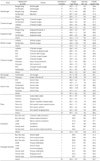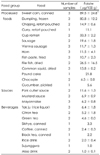Abstract
A trienzyme extraction method (use of α-amylase, protease and folate conjugase) for food folate assay has been used to release folate from the food matrix. In order to reduce the incubation time with three enzymes, folate values were compared between two incubation protocols; separate incubation (SI, incubated with α-amylase and conjugase separately for 2 hours after protease treatment) and combined incubation (CI, incubated with α-amylase and conjugase together for 2 hours after protease treatment) using 88 food items from 12 kinds of fast foods and processed foods. We found that folate values by CI were comparable to or higher than those by SI, indicating that CI might be a better extraction procedure to shorten the entire incubation time. We measured folate contents in 49 fast foods and 26 processed foods by microbiological assay after CI. Mean folate contents of one serving of various burgers ranged from 43.1 to 62.0 µg. One serving of French fries, pizza, sandwich and triangled kimbab contained a mean of 53.3, 28.4, 47.4, and 25.7 µg of folate, respectively. Folate contents of non-alcoholic beverages were very low, ranging from 1.0 to 5.2 µg/100 g. Some of our values were comparable to the values in the folate database published in Korean Nutrition Society, however, some of the published values were 140 times higher than the measured values in this study. Folate values measured by the more recent modifications here can be used to update Korean folate database to accurately estimate dietary folate intake
Figures and Tables
Table 1
Mean folate content in foods measured after separate incubation (SI) or combined incubation (CI)

References
4. Černá J, Káš J. New conception of folacin assay in starch or glycogen containing food samples. Nahrung. 1983. 27(10):957–964.

5. De Souza S, Eitenmiller R. Effects of different enzyme treatments on extraction of total folate from various foods prior to microbiological assay and radioassay. J Micronutr Anal. 1990. 7:37–57.
6. Martin JI, Lenden WO, Soliman AGM, Eitenmiller RR. Application of a tri-enzyme extraction for total folate determination in foods. J Assoc Off Anal Chem. 1990. 73(5):805–808.

7. Hyun TH, Tamura T. Trienzyme extraction in combination with microbiologic assay in food folate analysis: An updated review. Exp Biol Med. 2005. 230(7):444–454.

8. Ruggeri S, Vahteristo LT, Aguzzi A, Finglas P, Carnovale E. Determination of folate vitaminers in food and in Italian reference diet by high-performance liquid chromatography. J Chromatogr A. 1999. 855(1):237–245.

9. Rader JI, Weaver CM, Angyal G. Total folate in enriched cereal-grain products in the United States following fortification. Food Chem. 2000. 70(3):275–289.

10. Whittaker P, Tufaro PR, Rader JI. Iron and folate in fortified cereals. J Am Coll Nutr. 2001. 20(3):247–254.

11. Ginting E, Arcot J. High-performance liquid chromatographic determination of naturally occurring folates during tempe preparation. J Agric Food Chem. 2004. 52(26):7752–7758.

12. Ndaw S, Bergaentzlé M, Aoudé-Werner D, Lahély S, Hasselmann C. Determination of folates in foods by high-performance liquid chromatography with fluorescence detection after precolumn conversion to 5-methyltetrahydrofolates. J Chromatogr A. 2001. 928(1):77–90.

13. Konings EJM, Roomans HHS, Dorant E, Goldbohm RA, Saris WHM, van den Brandt PA. Folate intake of the Dutch population according to newly established liquid chromatography data for foods. Am J Clin Nutr. 2001. 73(4):765–776.

14. Jin HO, Lim HS. Major foods for folate and their folate contents of Korean child-bearing women. J Korean Soc Food Sci Nutr. 2001. 30(1):152–158.
15. Yon M, Hyun TH. Folate content of foods commonly consumed in Korea measured after trienzyme extraction. Nutr Res. 2003. 23(6):735–746.

16. Han YH, Yon M, Hyun TH. Folate intake estimated with an updated database and its association to blood folate and homocysteine in Korean college students. Eur J Clin Nutr. 2005. 59(2):246–254.

17. The Korean Nutrition Society. Recommended Dietary Allowances for Koreans. 2000. Seoul: 7th revision.
18. National Rural Living Science Institute. Food Composition Table. 2006. Rural Development Administration;7th revision.
19. Yon M, Hyun T. Additional data for folate database for foods common in Korea. Korean J Nutr. 2005. 38(7):586–604.
20. Hyun T, Han YH. Comparison of folate intake and food sources in college students using the 6th vs. 7th nutrient database. Korean J Nutr. 2001. 34(7):797–809.
21. Ministry of Health and Welfare. The Third Korea National Health & Nutrition Examination Survey (KNHANES III). 2005-Nutrition Survey (II). 2006.
22. Hyun T, Han YH, Lim EY. Blood folate level determined by microplate reader and folate intake measured by a weighed food record. Korean J Community Nutrition. 1999. 4(4):512–520.
23. Johnston KE, Lofgren PA, Tamura T. Folate concentrations of fast foods measured by trienzyme extraxtion method. Food Res Int. 2002. 35(6):565–569.

24. Food and Drug Administration. Food standards: amendment of standards of identify for enriched grain products to require addition of folic acid. Federal Regist. 1996. 61(44):8781–8797.
25. Composition of foods, raw, processed, prepared. USDA National nutrient database for standard reference. United States Department of Agriculture. Release 21, 2008. Available from:http://www.nal.usda.gov/fnic/foodcomp.
26. Williams WL, Broquist HP, Snell EE. Oleic acid and related compounds as growth factors for lactic acid bacteria. J Biol Chem. 1947. 170(2):619–630.





 PDF
PDF ePub
ePub Citation
Citation Print
Print






 XML Download
XML Download